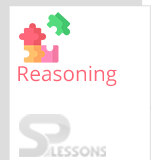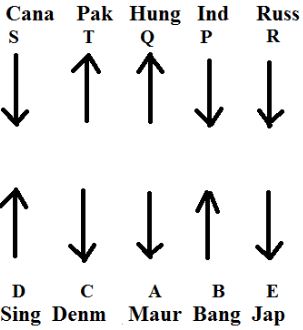 Introduction
Introduction
What is Reasoning Ability Test?
A logical reasoning test is a form of psychometric testing that is widely used by corporate employers to help assess candidates during their recruitment process. ‘Psychometric’ is just a fancy way of saying ‘measuring mental ability’ and logical reasoning tests are designed to measure your non-verbal skills.
The article IBPS RRB Reasoning Ability Quiz 8 provides Reasoning Ability questions with answers useful to the candidates preparing for Competitive exams, Entrance exams, Interviews etc. IBPS RRB has released IBPS RRB Officer 2019 Official Notification for Officer Scale(I, II, and II). Reasoning Ability plays major role to qualify examination. The article IBPS RRB Reasoning Ability Quiz 8 will assist the students understanding of the type of questions expected from the topic Reasoning Ability. IBPS RRB 2019 Office Assistant Preliminary Exam will be conducted on 17th, 18th & 25th August 2019 and the Mains Exam will be conducted on 29th September 2019.
 Quiz
Quiz
Direction(1-5): Study the following information carefully to answer the given questions.
Eight People – A, B, C, D, E, F, G and H live in eight different floors of building (but not necessarily in the same order). The lowermost floor of the building is numbered one, the one above that is numbered two, and so on till the topmost floor is numbered eight. Each one of them also owns a different brands of laptops, namely Acer, Lenovo, Dell, HP, Samsung, Apple, Asus and TOSHIBA (but not necessarily in the same order). F lives an odd numbered floor above the floor numbered four. Only one person lives between B and the one who owns Samsung. Only three people live between D and the one who owns Apple. The one who owns Asus lives immediately above G, G owns neither Apple nor Acer. E does not own Asus. Only three people live between G and A. The one who owns TOSHIBA lives immediately above the one who owns Lenovo, but not on the topmost floor. C lives an one of the odd numbered floors above the one who owns Apple. Only one person lives between F and the one who owns DELL. Only one person lives between the one who owns TOSHIBA and H. Only two people live between C and the one who owns Acer. The number of people leaving above F is same as the number of people living between F and D.
1. Which of the following Statements is true with respect to the given information?
- A. G lives immediately above the one who owns Apple
B. E lives immediately above C
C. Only three people live between F and the one who owns TOSHIBA.
D. D owns Samsung.
E. All the given statements are true.
- A. B, C
B. G, D
C. F, G
D. A, B
E. E, A
- A. TOSHIBA
B. Lenovo
C. DELL
D. Samsung
E. Asus
- A. G – HP
B. C – Apple
C. F – Samsung
D. H – TOSHIBA
E. D – DELL
- A. Four
B. Three
C. Two
D. Five
E. None
| Floor No | Person | laptops |
|---|---|---|
| 8 | B | HP |
| 7 | C | Asus |
| 6 | G | Samsung |
| 5 | F | Apple |
| 4 | H | Acer |
| 3 | E | DELL |
| 2 | A | TOSHIBA |
| 1 | D | Lenovo |
Direction(1-5): Study the following information carefully to answer the given questions.
Ten persons from ten different countries viz. Denmark, Japan, Pakistan, India, Mauritius, Canada, Hungary, Bangladesh, Russia and Singapore are sitting in two parallel rows containing five people each, in such a way that there is an equal distance between adjacent persons. In row 1- A, B, C, D and E are seated and some of them are facing South and some of them are facing North. In row 2 – P, Q, R, S and T are seated and some of them are facing South and some of them are facing North. Therefore in the given seating arrangement, each member seated in a row either faces another member of the other row or seated behind each other.(All the information given above does not necessarily represent the order of seating in the final arrangement.)
S is not from Pakistan. D is neither from Mauritius nor from Canada. P sits immediate right of the person from Russia. R sits one of the extreme ends of the line and from Russia. C sits third to the right of person from Japan. P does not face A and faces south direction. The person from Denmark sits exactly between the persons from Singapore and Mauritius. The person from Canada faces the person from Singapore. T faces North Direction and sits immediate left of Q. Only one person sit between the persons from Pakistan and India. The person from India sits to the immediate right of Q, who seated exactly in the middle of the row. P faces one of the immediate neighbors of the person from Japan. D faces one of the immediate neighbors of the person from Pakistan. Only One person sits between the person from Russia and Q. C sits to the immediate right of the person who faces S. Only two people sit between C and E. S is neither from Denmark nor from Bangladesh. The person from Mauritius sits second to the right of the one who faces North Direction. One of the immediate neighbors of the person from Mauritius behind the person from Pakistan. A faces the opposite direction to the person from Hungary.
1. Who amongst the following faces the person from Canada?
- A. The person from Denmark
B. D
C. The person from Mauritius
D. The person from Russia
E. B or E
- A. Pakistan
B. India
C. Hungary
D. Russia
E. Mauritius
- A. C faces south direction.
B. None of the given options is true
C. C is from Bangladesh
D. The person from India faces C
E. The person from Hungary is an immediate neighbor of C
- A. Denmark
B. Sri Nagar
C. Pakistan
D. Russia
E. Canada
- A. The person from Denmark and R
B. The persons from Bangladesh and A
C. D and the person from Japan
D. The persons from Canada and Pakistan
E. A,E
1. Statements: M<P≤G = F≥B; H≥F<I; J≥P
Conclusions: H≥J, B<I
- A. Only I is true
B. Only II is true
C. Either I or II true
D. Neither I nor II is true
E. Both I and II are true
- A. 58
B. 60
C. 27
D. 82
E. None of the above
- A. 69
B. 85
C. 101
D. 121
E. None of the above
- A. Niece
B. Nephew
C. Aunt
D. Sister-in-law
E. None of these
- A. S
B. R
C. X
D. C
E. None of these
Other Articles
 Study Guide
Study Guide
 Exams
Exams
| Competitive Exams - Entrance Exams | |||
|---|---|---|---|
| Category | Notification | ||
| UG | NSTSE 2020 | RIMC Admission 2020 | WBJEE EVETS 2019 |
| Diploma | HPBOSE D.El.Ed CET 2019 | Goa Diploma Admissions 2019 | |
PG |
GATE 2020 |
ATMA 2019 |
XAT 2020 |
| Click Here For – All India Entrance Exam Notifications | |||
 Daily CA
Daily CA
 Job-Alerts
Job-Alerts
 SP Quiz
SP Quiz
| Competitive Exams - Practice Sets | |
|---|---|
| Category | Quiz |
| English Language | Spotting Errors |
| Quantitative Aptitude | Permutation and Combination |
| Data Interpretation | |
 GK
GK
| General Knowledge for Competitive Examinations | |
|---|---|
| Topic | Name of the Article |
| GK - World | Miss Universe Titleholders |
| Multinational Companies Headquarters | |
| First in World | |
| GK - India | Padma Awards |
| Union Budget 2019 – Interim Budget | |
| Indian Famous Sites | |
| GK - Abbreviations | Finance Abbreviations |
| Computer Aptitude Abbreviations | |
| GK - Banking & Insurance | Banking Channels |
| Australia Countries Capitals Currencies | |
| GK - Science & Technology | Vitamins and Food Sources |
| Medical Science Discoveries | |
| pH Value | |




